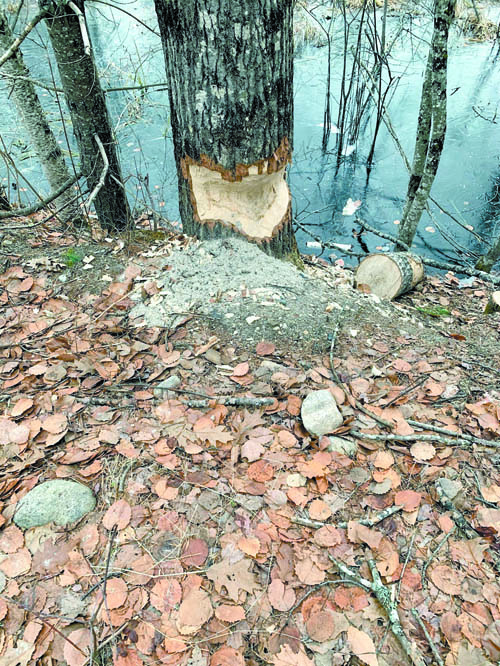Earth Notes: Keeping tabs on a new neighbor

By Alice Rose
Guest Columnist
Mid-morning one day late summer, I am on a break from weeding a flower bed and walking one of my dogs down the private dirt road on which we live. I am in the act of reigning in Dane’s exuberance when some movement in the swampy pond catches my attention. I turn in that direction to find swimming toward the road a large, mostly submerged brown critter. If Dane had not been with me, I would have stood quietly watching it, but not wanting to end up face down in the murky water when he went after it, we moved on before he noticed it too.
This was the first, but not the last time I saw one of a pair of beavers that had set up housekeeping in the neighborhood sometime the previous spring, building an impressive lodge in the small pond not far from the edge of the road. Throughout the summer and into fall, I watched the level of the water dammed up behind it rise and fall. The land is low in that area and the concern was for flooding of the road. In addition, the beavers were indeed busy and throughout the summer and fall took down trees along the pond side of the road, trees that invariably ended lying across the road blocking it.
Unlike other rodents, beavers are strictly vegetarians, with a definite preference for feeding on the inner bark of trees and their leaves and twigs. Poplars appear to be their favorite food source, which unfortunately for us, are the principal tree along that slice of the road, although they occasionally did choose other deciduous varieties. For an animal that at its largest is the size of a medium size dog, its sharp teeth and powerful jaws were impressive, managing to topple even sizable trees.
Years ago, at an auction, I came across two items, a beaver jacket and a beaver full-length coat, both luxurious and warm and despite being old in remarkably good condition. Although beavers were hunted for food as well, it was these characteristics – warmth, beauty and durability of their fur — that led to the near extinction of the European beaver. Although the North American beaver fared better, it too was decimated by hunting and as time went on by habitat loss.
Conservation efforts and changes in what’s fashionable have deprived the beaver of (from our perspective, of course) its “commodity value.” However, like the bear, the coyote, the wolf and other wild things, its place in our collective imagination remains, as does its intrinsic value as living beings. For example, the beaver appears in Aesop’s Fables, in numerous Native American and European folktales, and in popular stories such as C.S. Lewis’ The Lion, the Witch and the Wardrobe. Our language includes familiar phrases like “eager beavers” and “busy beavers.” Inconvenient to my comings and goings down the road and a nuisance to my neighbor whose property includes the pond and who must have the trees removed from the roadway, I’ve added the phrase “darn beavers” to those more familiar ones. But the truth of it is, the beavers going about their business oblivious to us provides a necessary and humbling perspective on our place in the natural world, a reminder that we are only one being among many on this planet.
When spring finally arrives and the ice is gone, the beaver and their progeny will start feeding on the remaining trees along the road. I hope those trees will land in the pond and not in the road and hope that the water remains in the pond where we think it belongs.


